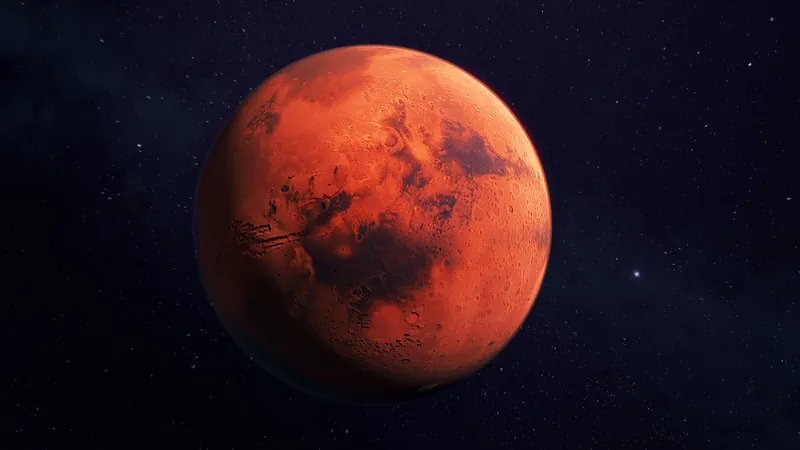
Extraordinary Discoveries: NASA Finds Evidence of Life's Potential on Mars!
2025-09-18
Author: Ming
NASA's Groundbreaking Mars Rover Findings
NASA's Perseverance rover has unearthed stunning evidence suggesting that Mars may have hosted life, revealing a tantalizing history of flowing water across the Red Planet!
An Ancient Habitat? Jezero Crater's Secrets!
In the Jezero Crater—a vast 28-mile-wide expanse—scientists have identified over two dozen types of minerals that point to a dynamic interplay of volcanic rock and liquid water. This intriguing discovery suggests that Jezero wasn't just a barren wasteland but could have been a haven for life on multiple occasions.
Three Epochs of Water Activity
Delving into the data, researchers discovered three distinct episodes of fluid activity that transformed Martian rocks into salts and clay minerals, hinting at varied environmental conditions.
1. **Harsh Beginnings**: The first episode featured high-temperature, acidic water, presenting extreme and inhospitable conditions for potential life.
2. **Moderate Marvels**: The second phase, characterized by more neutral water conditions, rapidly became a much more hospitable environment. This moderate setting expanded the potential for sustaining life.
3. **Alkaline Oasis**: The final phase introduced low-temperature, alkaline conditions—an ideal scenario that could have been highly conducive to life.
Insights from Research Leaders
Eleanor Moreland, a Rice University graduate student and leader of the study, expressed the excitement of these findings: 'The minerals we find in Jezero support multiple episodes of fluid alteration, indicating several times in Mars' history when volcanic rocks interacted with liquid water.'
Evidence of Ancient Water Bodies!
Perseverance's journey began in February 2021, focused on unraveling the mystery of ancient life in Jezero. The rover's findings confirm that this crater once housed a massive ancient lake and river delta, uncovering bizarre rock formations and organic molecules.
Sophisticated Tools for Discovery!
To make sense of its findings, the rover team employed cutting-edge technology: the Mineral Identification by Stoichiometry (MIST) algorithm and the Planetary Instrument for X-ray Lithochemistry (PIXL). This remarkable toolkit enables scientists to accurately identify minerals by cross-referencing measurements with a comprehensive mineral database.
What Does It Mean for Life on Mars?
Co-author Kirsten Siebach highlighted the implications of these findings: 'While harsh conditions seemed unsuitable for life, our Earthly knowledge shows that life can exist in extreme environments, such as the acidic pools of Yellowstone. Therefore, it doesn’t eliminate the possibility of habitability on Mars!'
A Historic Archive for Future Analysis!
This research not only enhances our understanding of Mars but also builds a crucial mineralogical record of Jezero Crater. Moreland emphasizes the importance of a robust error analysis model, providing confidence in their mineral matches—insight that will prove invaluable when future samples are brought back to Earth.
Conclusion: Mars’ Dynamic History!
These groundbreaking findings reinforce the notion that Jezero Crater, once a cradle for Martian lakes, harbored a chaotic and evolving history of water activity—one that makes us wonder: Could life have thrived here?




 Brasil (PT)
Brasil (PT)
 Canada (EN)
Canada (EN)
 Chile (ES)
Chile (ES)
 Česko (CS)
Česko (CS)
 대한민국 (KO)
대한민국 (KO)
 España (ES)
España (ES)
 France (FR)
France (FR)
 Hong Kong (EN)
Hong Kong (EN)
 Italia (IT)
Italia (IT)
 日本 (JA)
日本 (JA)
 Magyarország (HU)
Magyarország (HU)
 Norge (NO)
Norge (NO)
 Polska (PL)
Polska (PL)
 Schweiz (DE)
Schweiz (DE)
 Singapore (EN)
Singapore (EN)
 Sverige (SV)
Sverige (SV)
 Suomi (FI)
Suomi (FI)
 Türkiye (TR)
Türkiye (TR)
 الإمارات العربية المتحدة (AR)
الإمارات العربية المتحدة (AR)